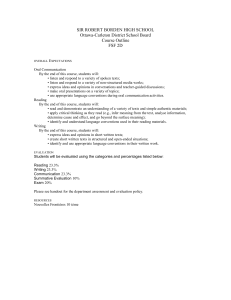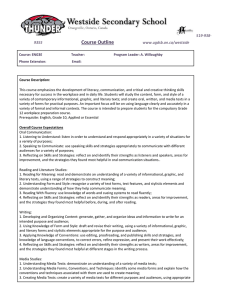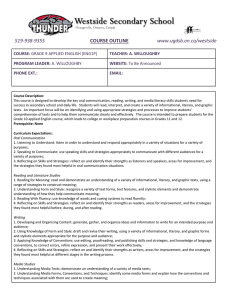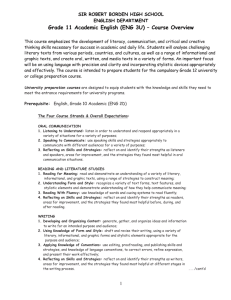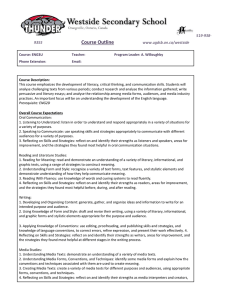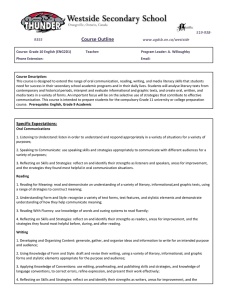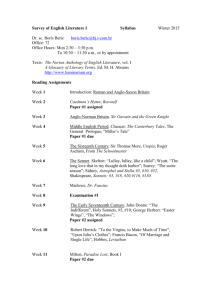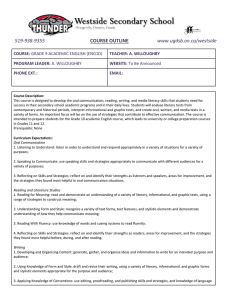Sir Robert Borden HS
advertisement
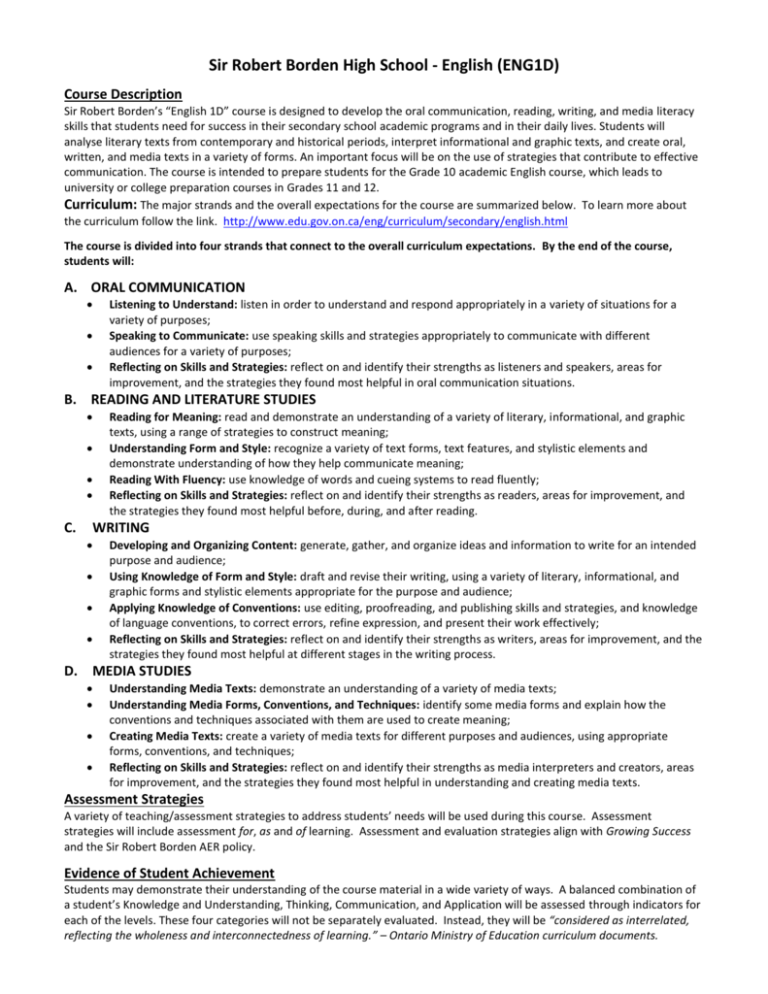
Sir Robert Borden High School - English (ENG1D) Course Description Sir Robert Borden’s “English 1D” course is designed to develop the oral communication, reading, writing, and media literacy skills that students need for success in their secondary school academic programs and in their daily lives. Students will analyse literary texts from contemporary and historical periods, interpret informational and graphic texts, and create oral, written, and media texts in a variety of forms. An important focus will be on the use of strategies that contribute to effective communication. The course is intended to prepare students for the Grade 10 academic English course, which leads to university or college preparation courses in Grades 11 and 12. Curriculum: The major strands and the overall expectations for the course are summarized below. To learn more about the curriculum follow the link. http://www.edu.gov.on.ca/eng/curriculum/secondary/english.html The course is divided into four strands that connect to the overall curriculum expectations. By the end of the course, students will: A. ORAL COMMUNICATION Listening to Understand: listen in order to understand and respond appropriately in a variety of situations for a variety of purposes; Speaking to Communicate: use speaking skills and strategies appropriately to communicate with different audiences for a variety of purposes; Reflecting on Skills and Strategies: reflect on and identify their strengths as listeners and speakers, areas for improvement, and the strategies they found most helpful in oral communication situations. B. READING AND LITERATURE STUDIES C. Reading for Meaning: read and demonstrate an understanding of a variety of literary, informational, and graphic texts, using a range of strategies to construct meaning; Understanding Form and Style: recognize a variety of text forms, text features, and stylistic elements and demonstrate understanding of how they help communicate meaning; Reading With Fluency: use knowledge of words and cueing systems to read fluently; Reflecting on Skills and Strategies: reflect on and identify their strengths as readers, areas for improvement, and the strategies they found most helpful before, during, and after reading. WRITING Developing and Organizing Content: generate, gather, and organize ideas and information to write for an intended purpose and audience; Using Knowledge of Form and Style: draft and revise their writing, using a variety of literary, informational, and graphic forms and stylistic elements appropriate for the purpose and audience; Applying Knowledge of Conventions: use editing, proofreading, and publishing skills and strategies, and knowledge of language conventions, to correct errors, refine expression, and present their work effectively; Reflecting on Skills and Strategies: reflect on and identify their strengths as writers, areas for improvement, and the strategies they found most helpful at different stages in the writing process. D. MEDIA STUDIES Understanding Media Texts: demonstrate an understanding of a variety of media texts; Understanding Media Forms, Conventions, and Techniques: identify some media forms and explain how the conventions and techniques associated with them are used to create meaning; Creating Media Texts: create a variety of media texts for different purposes and audiences, using appropriate forms, conventions, and techniques; Reflecting on Skills and Strategies: reflect on and identify their strengths as media interpreters and creators, areas for improvement, and the strategies they found most helpful in understanding and creating media texts. Assessment Strategies A variety of teaching/assessment strategies to address students’ needs will be used during this course. Assessment strategies will include assessment for, as and of learning. Assessment and evaluation strategies align with Growing Success and the Sir Robert Borden AER policy. Evidence of Student Achievement Students may demonstrate their understanding of the course material in a wide variety of ways. A balanced combination of a student’s Knowledge and Understanding, Thinking, Communication, and Application will be assessed through indicators for each of the levels. These four categories will not be separately evaluated. Instead, they will be “considered as interrelated, reflecting the wholeness and interconnectedness of learning.” – Ontario Ministry of Education curriculum documents. Source of Evidence Observations Conversations P r o d u c t s Tests Assignments Tasks Summative Task Final Examination Description The teacher may record evidence of student achievement observed as students work on investigations in class. The teacher may record evidence of student achievement obtained during a conversation with a student There will be major unit tests. Students may complete in-class assignments. Students may demonstrate their creativity, knowledge and understanding of the material through in-class performance tasks. Students will show evidence of their learning by performing a task that will include many overall expectations of the course. There will be an examination during the examination week. A Sight Passage will be schedule at the end of the course by your teacher. Term Work and Summative Evaluation The term work will account for 70% of the course; Summative Evaluation based upon an Independent Novel Study (10%); and a Final Examination (20%) Achievement Level & Percentage Mark Range Student evaluation will be reported in the form of levels with the following percentages: 4 + 95 -100 4 87 – 94 4 – 80 – 86 3 + 77 - 79 3 73 - 76 3 – 70 -72 2 + 67 - 69 2 63 - 66 2 – 60 - 62 1 + 57 - 59 1 53 - 56 1 – 50 – 52 UNITS OF STUDY: RESOURCES: Short Stories Sightlines 9 Mythology The Book of Myths Novel Study To Kill a Mockingbird – by Harper Lee Drama Study Twelfth Night – by William Shakespeare Poetry Sightlines 9 Grade 10 Literacy Test Preparation Literacy Power Workbook Language Usage (ongoing) Handouts

